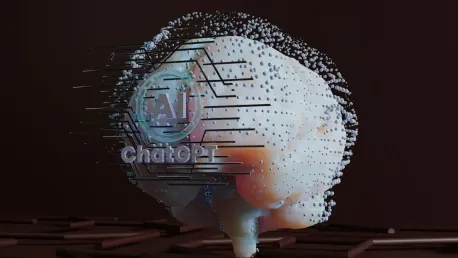ChatGPT, an AI chatbot developed by OpenAI, has revolutionized the way we interact with technology by leveraging advanced natural language processing (NLP) to enable human-like conversations and assist with numerous tasks across various industries. From providing customer support to aiding educational efforts and contributing to creative projects, ChatGPT represents a major leap forward in AI capabilities. This article delves into the features, applications, and future prospects of ChatGPT, offering a comprehensive understanding of this transformative technology.
ChatGPT stands for Generative Pre-trained Transformer. The AI chatbot, created by OpenAI, uses NLP and machine learning to simulate human conversation effectively. The origins of this innovative chatbot are deeply rooted in OpenAI’s mission to advance artificial intelligence and handle tasks that require a nuanced understanding of language. By training it on extensive datasets, ChatGPT is capable of generating accurate, context-aware responses. Its transformative applications span industries like customer service, healthcare, and education, indicating its broad utility and adaptability.
The Evolution of ChatGPT
The journey of ChatGPT is marked by several iterative advancements that have considerably enhanced its capabilities. The initial model, GPT-1, was launched in 2018 and demonstrated basic language understanding and text generation features. Although limited in scope, GPT-1 laid the crucial groundwork for subsequent models by showcasing what could be achieved with the nascent technology.
In 2019, OpenAI introduced the GPT-2 model with a larger dataset that significantly improved contextual understanding and quality of responses. GPT-2 was not immediately released to the public due to concerns over its potential misuse, highlighting both the capabilities and the ethical considerations of powerful language models. The following year, GPT-3 marked a significant leap forward with 175 billion parameters that allowed it to excel at complex tasks such as content creation, coding assistance, and more sophisticated interactions.
The latest iteration, GPT-4, released in 2023, further refined the model with enhanced understanding, accuracy, and multilingual support. GPT-4 has solidified ChatGPT’s position as a cornerstone of AI-driven communication, excelling in tasks that require a higher degree of nuance and context. These improvements make ChatGPT a powerful tool in various fields, from creative writing to customer service, showcasing the continuous evolution and potential of AI technology.
Mechanics of ChatGPT
ChatGPT operates on OpenAI’s GPT architecture, which is a type of large language model powered by state-of-the-art AI technology. This architecture utilizes specialized algorithms to identify patterns in data sequences, enabling the generation of human-like responses. The neural architecture of ChatGPT employs deep learning techniques, particularly transformer networks, which are pivotal in predicting the next word, sentence, or paragraph by analyzing patterns within the training data.
The training methodology of ChatGPT involves two main phases: supervised learning and reinforcement learning. During the supervised learning phase, human trainers provide labeled data to instill foundational language skills into the model. Trainers create example conversations and rank potential responses, enabling ChatGPT to learn the patterns of accurate and contextually appropriate replies. The reinforcement learning phase further improves the model by using up-to-date data. Human trainers evaluate the model’s outputs and rank responses, which helps establish a reward system that aids ChatGPT in identifying optimal answers. This continuous feedback loop through supervised and reinforcement learning mechanisms enhances the accuracy and reliability of ChatGPT over time. The datasets used for training include a diverse array of sources, such as websites, books, and articles, ensuring a rich and comprehensive linguistic foundation.
Usage Instructions
To utilize ChatGPT, users can access the chatbot through OpenAI’s official website or compatible tools that offer integration with the AI model. Creating an account is a prerequisite for interaction, with the option to upgrade to ChatGPT Plus for enhanced features and capabilities. For effective use, interacting with the chatbot involves providing clear and specific prompts to obtain accurate and relevant responses.
Users can also explore various settings and integration options to expand the scope of ChatGPT’s applications. For instance, linking the chatbot with specific tools or platforms can streamline workflows and enhance productivity in different areas such as customer service, content creation, and educational assistance. By experimenting with different prompts and exploring the additional functionalities available through upgrades, users can fully leverage ChatGPT’s versatile capabilities for a wide range of purposes.
Applications of ChatGPT
ChatGPT’s versatility extends across several key applications, significantly benefiting a wide range of industries. In customer service and support, ChatGPT automates responses to efficiently handle inquiries, providing instant 24/7 support. This reduces response times, resolves common issues quickly, and enhances overall customer satisfaction. By addressing frequent and straightforward queries, ChatGPT allows human agents to focus on more complex and nuanced issues that require human intervention.
In the realm of content creation, ChatGPT assists writers, marketers, and content creators by generating articles, blog posts, reports, marketing materials, scripts, and more with clear, context-aware responses. Its capabilities extend to helping with idea generation, plot development, and other creative writing tasks. For education, ChatGPT serves as an invaluable tutor, answering questions, simplifying complex topics, aiding students with essays and presentations, and helping them understand new concepts. Educators also utilize ChatGPT for creating lesson plans and delivering engaging learning materials.
The entertainment industry benefits significantly from ChatGPT as well, with its ability to contribute to writing scripts, developing game narratives, brainstorming project ideas, and enhancing interactive storytelling in gaming. The flexibility and dynamism offered by ChatGPT make it an essential tool across various applications, demonstrating its broad utility and transformative impact.
Benefits
ChatGPT presents numerous advantages to those who integrate it into their workflows and processes. One of the primary benefits is its efficiency; ChatGPT can quickly process and respond to queries, thus streamlining workflows and enhancing overall productivity. Its scalability ensures that it can handle multiple tasks and interactions simultaneously, making it suitable for businesses and organizations of all sizes and domains.
The user-friendly design of ChatGPT allows for simple and intuitive interaction, making it accessible to users with varying levels of technical expertise. Moreover, ChatGPT offers a cost-effective solution by automating repetitive and mundane tasks, which frees up human resources to tackle more complex challenges that require human ingenuity. Personalization is another significant advantage of ChatGPT; the AI tailors its responses to user input and context, boosting engagement and satisfaction by delivering more relevant and personalized interactions.
Challenges and Limitations
Despite the numerous benefits, ChatGPT also faces several inherent challenges and limitations that need to be addressed. Ethical concerns are at the forefront, as the AI can unintentionally generate harmful, misleading, or inappropriate content without proper safeguards. This poses significant risks, particularly in applications where accuracy and appropriateness are critical. The potential for misuse is another challenge, with the AI being at risk of exploitation for activities like spam, phishing scams, and fraudulent content creation.
Bias in responses is a notable issue; the training data may contain inherent biases, leading to unfair or discriminatory outputs. Addressing bias requires continuous efforts to diversify training datasets and implement strategies to reduce these biases. Additionally, ChatGPT’s performance heavily depends on the quality of the training data. Poor or outdated datasets can lead to inaccuracies and diminish the AI’s reliability. Furthermore, ChatGPT struggles with tasks that require deep reasoning, specialized knowledge, or niche expertise, highlighting the need for ongoing enhancement and refinement of the model’s capabilities.
ChatGPT vs. Other Chatbots
ChatGPT offers significant advantages in terms of conversational flexibility and ease of use compared to other chatbot models. For example, Google’s Bard excels in providing real-time, fact-checked responses by integrating with Google Search. While Bard focuses on delivering factual information efficiently, ChatGPT is often preferred for creative tasks and detailed, nuanced Q&A sessions.
Microsoft’s AI tools, on the other hand, are specialized for enhancing productivity, especially in conjunction with Office applications. ChatGPT, however, stands out with its versatility and ability to handle a broader range of tasks, from creative content generation to complex customer service interactions. The key differences between these chatbots include data access, availability, and ecological integration. Whereas Bard benefits from real-time data access via Google Search, ChatGPT relies on older datasets, and while ChatGPT offers a free version with premium plans for advanced features, Bard and Microsoft tools are frequently tied to their specific ecosystems.
Future Prospects
Looking ahead, the future of ChatGPT promises several exciting advancements and trends that will further enhance its capabilities and applications. Improved integration with virtual assistants, productivity applications, and customer service tools is anticipated, leading to more seamless and comprehensive AI-powered workflows. Additionally, the development of multimodal capabilities, where ChatGPT can process text, images, and audio, will result in richer and more immersive user experiences.
Ethical improvements remain a critical focus, with ongoing efforts to reduce biases, enhance safety measures, and ensure fairness and transparency in AI applications. By addressing these ethical considerations, ChatGPT’s future iterations can provide more reliable and equitable solutions. These advancements will not only bolster the model’s utility but also reinforce user trust and engagement.
Ethical Implications
The ethical considerations around using ChatGPT are complex and require careful attention. Privacy is a major concern because handling personal and sensitive data requires strong encryption and strict adherence to data protection laws. The risk of spreading misinformation is another significant issue since ChatGPT can produce content that seems accurate but may be incorrect or misleading. Effective content moderation and verification mechanisms are essential to address this problem.
Currently, regulation of AI technologies like ChatGPT is insufficient, making accountability and oversight difficult. Developing transparent guidelines and promoting ethical practices are critical in ensuring responsible AI usage. These ethical concerns underscore the importance of ongoing efforts to improve the safety, fairness, and reliability of AI-driven technologies like ChatGPT.
In conclusion, ChatGPT is a versatile and powerful AI tool that has greatly transformed communication and productivity in various sectors. Built on advanced GPT architecture, it assists with tasks ranging from content creation to customer support and education. Despite challenges like biases and potential misuse, responsible use and continuous development of ChatGPT enhance its utility and impact. Future advancements in personalization, ethical considerations, and multimodal integration aim to further secure ChatGPT’s role as a vital tool for businesses and individuals. This evolution of ChatGPT mirrors the broader path of AI development, highlighting both the potential and responsibility of harnessing such transformative technologies.









